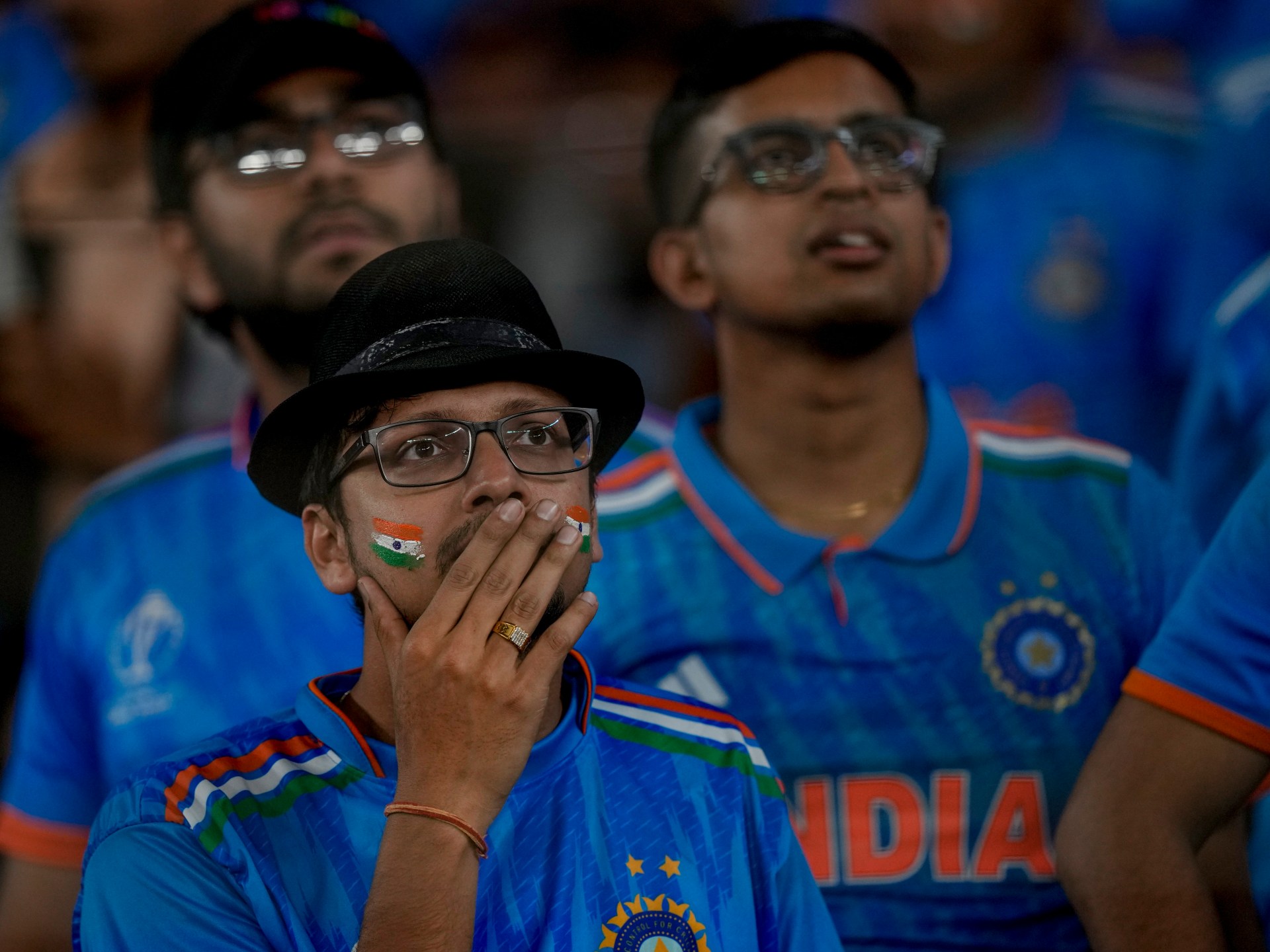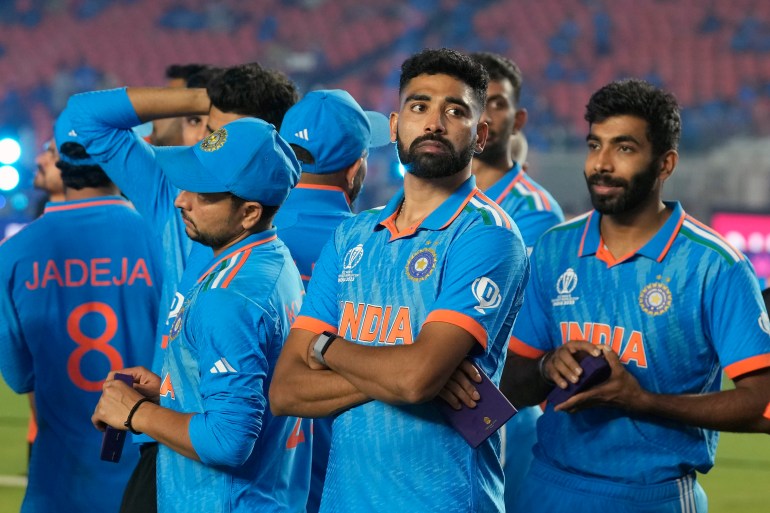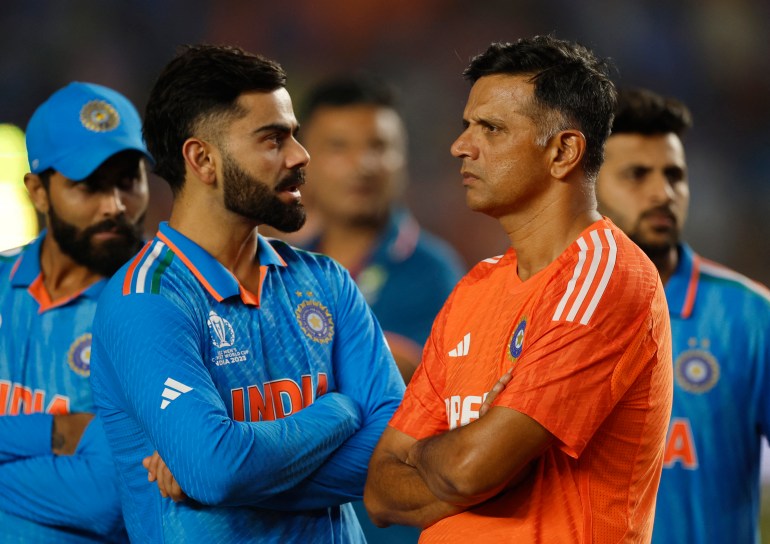
Mumbai, India – A deafening silence and empty rows of seats: the 2023 Cricket World Cup ended the same way it had begun.
The Narendra Modi Stadium in the western Indian state of Gujarat saw a withdrawal of fans long before Australia celebrated its winning streak The final on Sunday.
The Aussies are now six-time title winners. It was a dream come to an end for hosts India, who reached the final after ten games unbeaten.
“I was pretty excited about the game as it was my first time watching India in the World Cup, but it just wasn’t our day,” Sriraj Namboodiri told Al Jazeera over the phone from Ahmedabad.
The much-anticipated final had been a topic of discussion across the cricket-obsessed South Asian country, where people thronged restaurants, pubs and cafes to watch public screenings of the clash between India and Australia.
But as the Indian players stumbled and stared at defeat, thousands of fans in the 100,000-plus capacity stadium began leaving their seats before the game was over – a sad sight after India’s flawless route to the final.
“The crowd in the stadium was really bad. I didn’t enjoy the experience,” said Namboodiri, who came from Mumbai with his brother to watch the game.
“Had the game been held in Chennai or Mumbai, most fans would have stayed till the end for the award ceremony. After all, it was a World Cup final, the biggest game in world cricket, and it was taking place on our home soil.
“If you were a cricket fan, you would stay. If you leave, it will only be because you are a fake fan.”
Pretty pathetic considering the crowd that has already left the stadium. This team played like a dream for a month and a half. They – and world champions Australia – deserve proper applause at the end of this incredible game. No empty seats.
— Mihir Vasavda (@mihirsv) November 19, 2023
Annujj Palaye, a communications professional for a top-flight Indian soccer team, said it was “understandable” that Indian fans left early, but he said he was more disappointed that the crowd did not cheer for India in difficult moments.
“It’s a beautiful stadium and offers a great backdrop, which is probably why it was chosen for the final. But it didn’t seem like India had a home advantage,” Palaye said.
“The crowd was hyped up in the first 10 overs of both innings but remained mostly silent for the most part.”
Toss plays a big role
Namboodiri said the loss of the toss itself was a turning point for the host team.
“It was a black pitch, which is much more difficult to beat. The pitch was a bit sluggish and pacer-friendly,” explained Namboodiri, a sports media professional himself.
“As per India’s current batting strategy, Rohit [Sharma, Indian captain] usually gives the team a starting signal and Shubman Gill or Virat Kohli builds on that. Rohit did his job but Gill soon departed, putting pressure on Kohli and KL Rahul to get off to a steady start. Kohli was unlucky to get out and after that the team lost its anchor in the middle order,” he added.
According to Radha Lath Gupta, a management student from Ahmedabad who attended the final, India fell short of its target of 30 to 40 runs.
“The first 10 overs of Indian bowling were so exciting but the bowling change later became a bit predictable. Since we had fewer runs on the field, Australia could simply rotate the strike and get by. They didn’t have to play any risky shots,” she said.
“India didn’t apply any pressure while fielding either. Spinners Ravindra Jadeja and Kuldeep Yadav at both ends gave way [Travis] Head and Marnus Labuschagne have time to settle down. Once a top-class batsman gets into a World Cup final, it is quite difficult to get him out.”

In a post-match interview, former West Indies player and cricket commentator Ian Bishop praised Australia and said India lost to a team that had “championship DNA”.
Gupta agreed. “Australia had a decent World Cup run. They had challenges at the beginning that prepared them for the end. “Australia didn’t have a perfect tournament, but they had a run that peaked at the right time,” she said.
Sunday’s final was a repeat of the 2003 World Cup when Australia beat India by 125 runs in the final after then Australian captain Ricky Ponting’s 140 runs helped the team to an impressive score of 360.
Palaye, who watched the 2003 final on television, said the game was similar to this year’s summit.
“At that time, India were dominating the opposition and under Sourav Ganguly, an aggressive player, a new era of cricket was beginning [former] Indian captain. This was the new face of Indian cricket,” he said.
“Over 350 goals conceded after India’s performance in the season [2003] The tournament was like a punch in the gut. It was similar to this year’s final.”
What’s next for Sharma and Kohli?
Indian captain Rohit Sharma (36) and top batsman Virat Kohli (35) looked teary-eyed excellent campaign ended on a dull note – Kohli, player of the tournament, scored a record 765 runs at an average of 96 runs, while Sharma was the second highest scorer with 597 runs.
1⃣1⃣ games
7⃣6⃣5⃣ runs
6⃣ fifties
3⃣ hundreds 💯A round of applause for the player of the tournament and leading run scorer #CWC23 – Virat Kohli 👏👏#TeamIndia | #MenInBlue | #Final pic.twitter.com/PncstjqQPf
— BCCI (@BCCI) November 19, 2023
“In this World Cup, you saw a different Rohit with his fearless captaincy, someone who didn’t want to play pragmatically. That sums him up perfectly,” Palaye told Al Jazeera.
“I know Rohit may not get a chance to play in the World Cup again, but it won’t be a blight on his career.”
While India fans expect Sharma to play the 2027 edition of the tournament, they are also hoping to see the athletic Kohli play by then.
“As far as fitness is concerned, Kohli can play in 2027 but it depends on him. We can’t really say for sure what’s going on in his head,” Namboodiri said.
Gupta, on the other hand, is not sure.
“It is unlikely that a 39-year-old would play in a World Cup, but if there is anyone who could play at 39, it would be Kohli,” she said.

Australians are being mistreated online
Shortly after Australia’s players were covered in confetti as they celebrated their sixth World Cup triumph, some of them were insulted on social media.
Head, whose outstanding performance of 137 secured his team’s victory, was one of the main targets of online harassment and threats on Instagram, with some accounts even making rape threats against his wife.
Australian sports presenter and podcaster Ian Higgins also received abusive messages. New Zealand player Jimmy Neesham has shared screenshots of the abuse he received from Indian fans who mistook him for an Australian player.
Palaye condemned the fans’ behavior.
“I understand that sports tend to make people emotional, but you have to have a rational mind to know where to direct that anger,” he said.
“I don’t know where this hate even comes from, but these fans need to do a better job of harnessing this energy. Australia were the better team from the toss to the last ball – you just have to admit that.”






Recent Comments